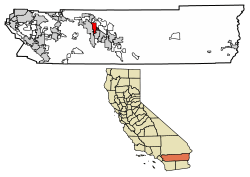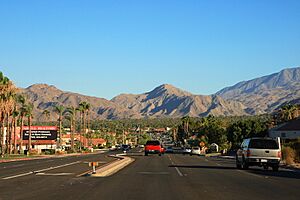Cathedral City, California facts for kids
Quick facts for kids
Cathedral City
|
||
|---|---|---|
| City of Cathedral City | ||

Cathedral City Hall
|
||
|
||

Location of Cathedral City in Riverside County, California.
|
||
| Country | United States | |
| State | California | |
| County | Riverside | |
| Native American Reservation (partial) | Agua Caliente Band of Cahuilla Indians | |
| Incorporated | November 16, 1981 | |
| Government | ||
| • Type | Council–Manager | |
| Area | ||
| • Total | 22.75 sq mi (58.93 km2) | |
| • Land | 22.49 sq mi (58.26 km2) | |
| • Water | 0.26 sq mi (0.67 km2) 1.18% | |
| Elevation | 328 ft (100 m) | |
| Population
(2020)
|
||
| • Total | 51,493 | |
| • Density | 2,289.19/sq mi (883.85/km2) | |
| Time zone | UTC-8 (Pacific) | |
| • Summer (DST) | UTC-7 (PDT) | |
| ZIP codes |
92234–92235
|
|
| Area codes | 442/760 | |
| FIPS code | 06-12048 | |
| GNIS feature IDs | 1656454, 2409412 | |
Cathedral City, also known as "Cat City", is a fun desert city in Riverside County, California. It's located in the Coachella Valley, a part of the Colorado Desert. You can find it between Palm Springs and Rancho Mirage.
Cathedral City is the second largest city in the Coachella Valley, after Indio. In 2020, about 51,493 people lived there.
Before European settlers arrived, the land belonged to the Cahuilla Native American people. Even today, some parts of the city are still part of the Agua Caliente Band of Cahuilla Indians reservation. The city started as a housing area in 1925 and officially became a city in 1981.
The city gets its name from Cathedral Canyon, which is south of the city in the Santa Rosa and San Jacinto Mountains National Monument. People said that some rock shapes in the canyon looked like a cathedral. However, a big flood in 1946 changed these rock formations.
Interestingly, in the United Kingdom, a "cathedral city" usually means a city with a cathedral. This led Robert Ripley to write in his "Believe It Or Not" column in 1939, "Believe it or not … there is no church in Cathedral City, Calif. It is named after a canyon."
Contents
History of Cathedral City
Early Beginnings: Before 1860
Cathedral City is located in the northwestern part of the Coachella Valley. It's surrounded by mountains: the San Bernardino Mountains to the north and the San Jacinto Mountains to the south. The San Gorgonio Pass is to the west.
The first people to live here were the Cahuilla Indians. They arrived in this area around 3,000 BCE. The Cahuilla lived in groups, and the Agua Caliente Band of Cahuilla Indians lived on the land where Cathedral City is now.
The land was claimed by Spain in 1768. Then, in 1821, it became part of Mexico. After the Mexican–American War in 1848, the land became part of the United States. It officially joined the State of California in 1850.
In 1852, a US Army Colonel named Henry Washington surveyed Southern California. In 1855, he surveyed the Coachella Valley. During this survey, he found and named Cathedral Canyon. This canyon is where Cathedral City later got its name.
Before the city was built, only the Cahuilla people lived here. A few explorers and soldiers passed through, but no one built permanent homes.
Travel Routes: 1860s to Early 1900s
Before the 1860s, the main paths through the Coachella Valley were trading routes used by Native American tribes. One of these paths went through the area that would become Cathedral City.
In 1862, the Colorado River Gold Rush started. This led William D. Bradshaw to find a faster way from Los Angeles to the Colorado River. He mapped a route that went through the San Gorgonio Pass and the Coachella Valley. This route followed some of the old Cahuilla trading paths.
Soon, stagecoach and freight companies used this route. It became known as the Bradshaw Trail or "Gold Road." This trail brought miners, supplies, and mail. The Bradshaw Trail passed through the future Cathedral City. Later, this trail became the basis for modern roads like Palm Canyon Drive and Highway 111.
Nightclubs of the 1930s
In the 1930s and early 1940s, several popular nightclubs opened just outside Palm Springs' city limits. These included the Dunes Club, the 139 Club, and the Cove Club.
Modern Cathedral City

Cathedral City has grown a lot since it became an official city in 1981.
In the late 1990s, the city started a project to improve its downtown area. This project was mostly finished by 2005. A new city hall was built, along with an IMAX/Mary Pickford movie theater. Many new or updated stores and restaurants also opened.
Recently, the city built an outdoor amphitheater next to the city hall. This space now hosts several yearly festivals and events. A new shopping center, Cathedral City Cove, also began construction in 2023.
Geography and Climate
Cathedral City covers about 21.8 square miles (56.5 square kilometers). Most of this area is land, with a small part being water.
| Climate data for Cathedral City, California | |||||||||||||
|---|---|---|---|---|---|---|---|---|---|---|---|---|---|
| Month | Jan | Feb | Mar | Apr | May | Jun | Jul | Aug | Sep | Oct | Nov | Dec | Year |
| Record high °F (°C) | 98 (37) |
105 (41) |
105 (41) |
110 (43) |
118 (48) |
121 (49) |
122 (50) |
121 (49) |
121 (49) |
110 (43) |
98 (37) |
93 (34) |
122 (50) |
| Mean daily maximum °F (°C) | 70.4 (21.3) |
73.7 (23.2) |
79.9 (26.6) |
86.5 (30.3) |
94.8 (34.9) |
102.8 (39.3) |
107.6 (42.0) |
106.7 (41.5) |
101.3 (38.5) |
90.6 (32.6) |
78.2 (25.7) |
68.8 (20.4) |
88.4 (31.3) |
| Mean daily minimum °F (°C) | 45.4 (7.4) |
48.0 (8.9) |
53.0 (11.7) |
58.1 (14.5) |
65.3 (18.5) |
71.8 (22.1) |
78.1 (25.6) |
78.2 (25.7) |
72.6 (22.6) |
62.6 (17.0) |
51.8 (11.0) |
44.2 (6.8) |
60.8 (16.0) |
| Record low °F (°C) | 18 (−8) |
24 (−4) |
29 (−2) |
35 (2) |
38 (3) |
48 (9) |
54 (12) |
52 (11) |
46 (8) |
30 (−1) |
26 (−3) |
23 (−5) |
18 (−8) |
| Average precipitation inches (mm) | 1.15 (29) |
1.02 (26) |
0.58 (15) |
0.08 (2.0) |
0.06 (1.5) |
0.05 (1.3) |
0.17 (4.3) |
0.38 (9.7) |
0.39 (9.9) |
0.12 (3.0) |
0.28 (7.1) |
0.57 (14) |
4.85 (123) |
People of Cathedral City
| Historical population | |||
|---|---|---|---|
| Census | Pop. | %± | |
| 1960 | 1,855 | — | |
| 1970 | 3,640 | 96.2% | |
| 1980 | 4,130 | 13.5% | |
| 1990 | 30,085 | 628.5% | |
| 2000 | 42,647 | 41.8% | |
| 2010 | 51,200 | 20.1% | |
| 2020 | 51,493 | 0.6% | |
| U.S. Decennial Census | |||
Population in 2010
In 2010, Cathedral City had a population of 51,200 people. About 63.5% of the people were White. About 58.8% of the people were of Hispanic or Latino background.
There were 17,047 households in the city. About 38.6% of these households had children under 18 living there. The average household had about 3 people.
The population included many young people, with 27.1% under the age of 18. The median age in the city was 36 years old.
Population in 2000
In 2000, the city's population was 42,647. About half of the people (50%) were Hispanic or Latino.
There were 14,027 households. About 39.3% of these households had children under 18. The average household size was about 3 people.
The population was spread out across different age groups. About 31.1% of the people were under 18 years old. The median age was 32 years. Cathedral City has many communities for senior citizens and mobile home parks.
Economy
Cathedral City has a large area for car dealerships called the Palm Springs Auto Mall.
The city also hosts an annual Mexican Independence Day festival every September. This event includes a special ceremony called "el Grito de Dolores" at the city hall complex.
Parks and Fun Things to Do
Cathedral City has many places for sports and recreation.
The Date Palm Country Club has an 18-hole golf course. It was designed in 1967 and opened in 1971. The course has lakes and sand traps, making it a fun challenge for golfers.
The Big League Dreams Sports Park is a softball complex. It has four softball fields that look like famous major league baseball stadiums! The Pepsi All-Star Softball Game has been held here since 1998. The Cathedral City Soccer Park is another sports spot. The So Cal Coyotes minor league football team used to play some of their games there.
The city has nine parks for everyone to enjoy:
- Century Park
- Dog Park
- Dennis Keat Soccer Park
- Memorial Park
- Ocotillo Park
- Panorama Park
- Patriot Park
- Second Street Park
- Town Square
There are also several golf resorts in Cathedral City, including the Desert Oasis Hotel/resort, Cimarron Golf Resort, and the Desert Princess Palm Springs Resort and Golf Club.
Education
Cathedral City High School opened in 1991. It's an important place for both education and sports in the city. Its sports teams have won championships in football, basketball, and soccer.
Cathedral City is also home to Mayfield College. This is a private college that helps students get ready for careers in healthcare, technology, and business.
Famous People from Cathedral City

Many famous people have lived in or are connected to Cathedral City.
Actors Robert Duvall and Martin Landau used to spend their winters here in the 1960s. TV host Monty Hall also lived here in the 1990s.
The grave of famous singer Frank Sinatra is in the Desert Memorial Park cemetery in Cathedral City. Other well-known people buried there include actor William Powell, singer-songwriter Sonny Bono (who was also a mayor of Palm Springs), and actress Jane Wyman.
Other notable people include:
- Timothy Bradley (born 1983), a former boxing champion, grew up here and went to Cathedral City High School.
- Lalo Guerrero (1916–2005), a famous Chicano folk musician, lived in Cathedral City in his later years.
- Simon Oakland (1915–1983), an American actor, passed away in the town.
- Agnes Lawrence Pelton (1881–1961), a German-born modernist painter, lived in Cathedral City for 29 years. A street, F Street, was renamed Agnes Pelton Way in her honor.
See also
 In Spanish: Cathedral City para niños
In Spanish: Cathedral City para niños



